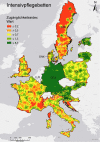[Intensive care back up for infectious disease disasters]
- PMID: 33037459
- PMCID: PMC7546520
- DOI: 10.1007/s00063-020-00743-7
[Intensive care back up for infectious disease disasters]
Abstract
Background: Outbreaks of infectious diseases pose particular challenges for hospitals and intensive care units.
Objectives: Typical infectiological scenarios and their significance for modern intensive care medicine are presented.
Materials and methods: Selected pathogens/infectious diseases that have significantly strained the resources of intensive care units are described.
Results: Intensive medical care is necessary in severe cases of many infectious diseases. In the context of epidemics/pandemics, many critically ill patients have to be admitted within a short time. Examples are the 2009 H1N1 influenza pandemic, the 2011 enterohemorrhagic Escherichia coli (EHEC) outbreak in northern Germany, the 2014/2015 Ebola fever outbreak and the 2020 coronavirus disease 19 (COVID-19) pandemic. Multidisciplinary teams, protocol development, adequate staffing, and training are required to achieve optimal treatment outcomes, including prevention of healthcare worker infections.
Conclusions: Pandemics and epidemics are unique challenges for intensive care unit preparedness planning.
Zusammenfassung: HINTERGRUND: Ausbrüche von Infektionskrankheiten stellen Krankenhäuser und Intensivstationen vor besondere Herausforderungen.
Ziel der arbeit: Es werden grundlegende infektiologische Szenarien und ihre Bedeutung für die moderne Intensivmedizin dargestellt.
Material und methoden: Ausgewählte Erreger/Infektionskrankheiten, die das Potenzial haben, die Ressourcen der Intensivstationen deutlich zu belasten, werden beschrieben.
Ergebnisse: Eine Intensivmedizinische Betreuung ist bei schweren Verläufen vieler Infektionserkrankungen notwendig. Im Rahmen von Epidemien/Pandemien kann es innerhalb kurzer Zeit zu einer Aufnahme von vielen kritisch kranken Patienten kommen. Beispiele dafür sind die Pandemie im Jahr 2009 durch das Influenzavirus H1N1, der Ausbruch einer Infektion mit enterohämorrhagischen Escherichia coli (EHEC) in Norddeutschland, der Ebola-Fieber-Ausbruch in den Jahren 2014/2015 und die Pandemie durch die Coronaviruserkrankung 2019 (COVID-19) im Jahr 2020. Multidisziplinäre Teams, die Entwicklung von Protokollen, eine adäquate Personalbesetzung und Schulungen sind erforderlich, um ein optimales Behandlungsergebnis zu erzielen. Dies beinhaltet insbesondere auch die Prävention von Infektionen des Gesundheitspersonals.
Diskussion: Pandemien und Epidemien sind einzigartige Herausforderungen für die Bereitschaftsplanung der Intensivstation.
Keywords: Coronavirus; Enterohemorrhagic Escherichia coli; Human influenza; Pandemics; Personal protection equipment.
References
Publication types
MeSH terms
LinkOut - more resources
Full Text Sources
Medical






